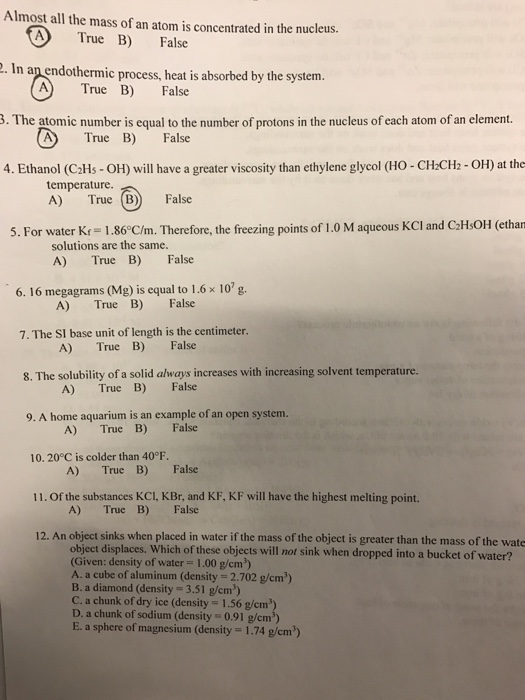Who did the Gold Foil Experiment?
- Almost The Entire Mass Of An Atom Is Concentrated In The __
- Almost The Entire Mass Of An Atom Is Concentrated In The Nucleus
- Almost The Entire Mass Of An Atom Is Concentrated In The
The α- particles have appreciable mass. These are deflected by the nucleus. It means that almost the entire mass of the atom lies at its center, i.e., entire mass of an atom is concentrated inside its nucleus.
The gold foil experiment was a pathbreaking work conducted by scientists Hans Geiger and Ernest Marsden under the supervision of Nobel laureate physicist Ernest Rutherford that led to the discovery of the proper structure of an atom. Known as the Geiger-Marsden experiment, it was performed at the Physical Laboratories of the University of Manchester between 1908 and 1913.
Gold Foil Experiment
- Numerically speaking, the nucleus of an atom occupies almost 10-14 times the volume of the atom but contains 99.99% of the atomic mass. The nucleus of an atom is so small that if you expanded an atom to fill up a room, the nucleus of an atom would still be no larger than a pinhead! Nucleus of an Atom – atomic mass. An atom is tiny.
- (d) An atom of an element has 11 protons, 11 electrons and 12 neutrons. The atomic mass of the atom is. (e) If the nucleus of an atom has atomic number 17, mass number 37 and there are 17 electrons outside the nucleus, the number of neutrons in it is. (f) Almost all the mass of an atom is concentrated in a small region of space.
History
The prevalent atomic theory at the time of the research was the plum pudding model that was developed by Lord Kelvin and further improved by J.J. Thomson. According to the theory, an atom was a positively charged sphere with the electrons embedded in it like plums in a Christmas pudding.
Almost The Entire Mass Of An Atom Is Concentrated In The __
With neutrons and protons yet to be discovered, the theory was derived following the classical Newtonian Physics. However, in the absence of experimental proof, this approach lacked proper acceptance by the scientific community.
What is the Gold Foil Experiment?
Description
The method used by scientists included the following experimental steps and procedure. They bombarded a thin gold foil of thickness approximately 8.6 x 10-6 cm with a beam of alpha particles in a vacuum. Alpha particles are positively charged particles with a mass of about four times that of a hydrogen atom and are found in radioactive natural substances. They used gold since it is highly malleable, producing sheets that can be only a few atoms thick, thereby ensuring smooth passage of the alpha particles. A circular screen coated with zinc sulfide surrounded the foil. Since the positively charged alpha particles possess mass and move very fast, it was hypothesized that they would penetrate the thin gold foil and land themselves on the screen, producing fluorescence in the part they struck.
Like the plum pudding model, since the positive charge of atoms was evenly distributed and too small as compared to that of the alpha particles, the deflection of the particulate matter was predicted to be less than a small fraction of a degree.
Observation

Though most of the alpha particles behaved as expected, there was a noticeable fraction of particles that got scattered by angles greater than 90 degrees. There were about 1 in every 2000 particles that got scattered by a full 180 degree, i.e., they retraced their path after hitting the gold foil.
Simulation
Simulation of Rutherford’s Gold Foil Experiment
Courtesy: University of Colorado Boulder
Almost The Entire Mass Of An Atom Is Concentrated In The Nucleus
Conclusion
Almost The Entire Mass Of An Atom Is Concentrated In The
The unexpected outcome could have only one explanation – a highly concentrated positive charge at the center of an atom that caused an electrostatic repulsion of the particles strong enough to bounce them back to their source. The particles that got deflected by huge angles passed close to the said concentrated mass. Most of the particles moved undeviated as there was no obstruction to their path, proving that the majority of an atom is empty.
In addition to the above, Rutherford concluded that since the central core could deflect the dense alpha particles, it shows that almost the entire mass of the atom is concentrated there. Rutherford named it the “nucleus” after experimenting with various gases. He also used materials other than gold for the foil, though the gold foil version gained the most popularity.
He further went on to reject the plum pudding model and developed a new atomic structure called the planetary model. In this model, a vastly empty atom holds a tiny nucleus at the center surrounded by a cloud of electrons. As a result of his gold foil experiment, Rutherford’s atomic theory holds good even today.

Rutherford’s Atomic Model

Rutherford’s Gold Foil Experiment Animation
Summary
- Rutherford demonstrated his experiment on bombarding thin gold foil with alpha particles contributed immensely to the atomic theory by proposing his nuclear atomic model.
- The nuclear model of the atom consists of a small and dense positively charged interior surrounded by a cloud of electrons.
- The significance and purpose of the gold foil experiment are still prevalent today. The discovery of the nucleus paved the way for further research, unraveling a list of unknown fundamental particles.
Article was last reviewed on Friday, August 14, 2020
Related articles
